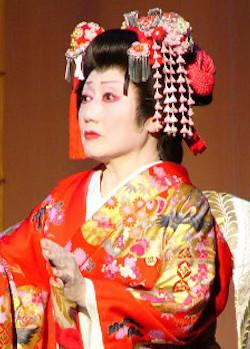Hamlet and Japan

Hamlet and Japan: An Evening of Talks and Performances
Sam Wanamaker Playhouse
Shakespeare’s Globe
7 July 2016
Review by Susan Meehan
Hamlet and Japan was an ambitious attempt to cover aspects of Shakespeare’s extensive history in Japan through talks, music and performances all in the space of a few hours. The overriding motif of the ‘variety show’ style evening was that our two nations draw strength from each other and that there is no better exemplar of this than in the performance of Shakespeare.
As two shamisen players opened proceedings, a hush descended over the tightly packed and expectant audience in the atmospherically candle-lit Sam Wanamaker Playhouse, a Jacobean-style 340-seat theatre within the Souhthbank’s Globe Theatre complex.
‘The words of Mercury are harsh after the songs of Apollo’, quoted Patrick Spottiswoode, Director, Globe Education as he greeted the audience and welcomed onto the stage British theatre producer and former actress Thelma Holt. In this evening’s celebration of Shakespeare, it was fitting to celebrate the life of the Japanese theatre director Yukio Ninagawa, renowned for his sumptuous adaptations of Shakespeare, and with whom Holt had collaborated on 21 productions since 1986.
Perched on a chair at the front of the stage, a large Hello Kitty bag firmly planted in front of her as a prop, the animated and passionate, yet visibly saddened Holt delivered a heartfelt tribute to her friend, the great man, Ninagawa.
The evening progressed apace with two fine academic presentations, which illustrated the fact that the British don’t hold a monopoly on Shakespeare.
Sir David Warren, former British ambassador to Japan, gave an erudite talk focusing on Shakespeare as a contemporary rather than classical influence in Japan. Japan discovered Shakespeare in the late nineteenth century when the country was dramatically transforming, modernising and industrialising in the wake of the Meiji Restoration (1868). Plays such as Julius Caesar, the title translated as The Rise and Fall of Rome and The Sword of Freedom by Keizō Kawashima (1859-1936) and Tsubouchi Shōyō (1859-1935) were politically relevant during Japan’s period of liberal awakening during the Taishō period (1912-1926).
Covering much ground, Warren also mentioned modern Japanese adaptations of Shakespeare such as Akira Kurosawa’s series of films including Ran (based on King Lear), Throne of Blood (based on Macbeth) and The Bad Sleep Well (based on Hamlet). He further whetted the audience’s appetite by mentioning acclaimed contemporary and radical Japanese theatre adaptations of Shakespeare by Hideki Noda.
Dr Todd Andrew Borlik, lecturer in the Department of English Literature at Hull University, proceeded to give a fascinating account of Natsume Sōseki’s negative response to Shakespeare. Sōseki (1867-1916) ‘audaciously’ criticised Shakespeare from ‘a Japanese point of view’, pointing out that the issue of suicide as seen in Hamlet is not so great a concern in a non-Christian country like Japan. Nor was the idea of a man marrying his sister-in-law – as with Gertrude and Claudius – problematic in Japan. Furthermore, the strong appetite for revenge in Japanese theatre can make Hamlet’s vacillation difficult to comprehend.
Following the intermission, the evening’s focus moved towards performances and readings from Hamlet.
Aki Isoda, Japan-based actress and Shakespearian, performed A Vision of Ophelia in kabuki style. Isoda’s three short pieces stripped Hamlet down to the action and words of Ophelia.
Isoda’s performances were in modern colloquial Japanese and without English surtitles. Her use of props (Hamlet’s love letters, flowers, the river), however, ensured that the entire audience knew which parts of Hamlet she was acting out.
Isoda’s performance was a testament to her longevity. Now in her 80s, she has been performing these pieces for around 45 years. We rarely, if ever, see an octogenarian perform such a young part. Her heavily whitened kabuki-style face – which made her seem far older than she otherwise appears – was startling. She is a tremendous supporter of Shakespeare and the Globe and her commitment to acting is to be greatly admired.
A comedic highlight of the evening was a reading of the first translation into Japanese of ‘To be or not to be’, written by Charles Wirgman, creator and editor in the 1860s of Japan Punch. The Japanese actor Sadao Ueda read the piece to the evident hilarity of the Japanese speakers in the crowd. He did this with tremendous style despite the quality of the doggerel. Patrick Spottiswoode in turn read Wirgman’s text – translated back into English, again in fine dramatic style. The result was extremely funny and had the audience laughing at phrases including ‘Would it be better if, my head hurts’ and ‘Or to take arm against this trouble sea’ and finishing ‘Goodbye to you, and then clap-clap.’
The evening came to a close with a conversation between Spottiswoode, Rosie Fielding – a PhD student specialising in theatre – Isoda’s costume and wig dressers and Isoda herself. They discussed the symbolism of the wigs and kimonos used by Isoda: pink kimono and long hair for innocence, red for passion and love, and unkempt hair and a brightly-coloured kimono with lots of yellow to reflect descent into grief and madness.
The evening’s accomplished performers, musicians and presenters marvellously achieved the aim of celebrating Shakespeare and Japan in this milestone 400th anniversary of Shakespeare’s birth. Though slightly overloaded by all that I had heard and seen, I felt fortunate to have been in the audience. Each one of the expert presentations could have formed the basis of an afternoon’s discussion in itself.
Referencing Spottiswoode, the words of Mercury did not disappoint or sound harsh at all!

